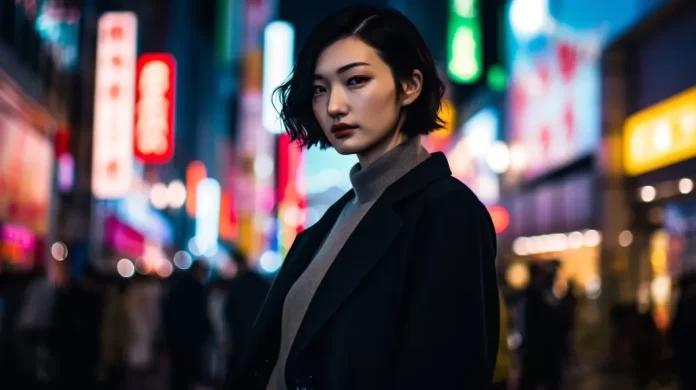Fashion is a cultural touchstone, a way for people to express themselves, their values, and their place in society. Nowhere is this more evident than in the realm of Japanese women’s fashion.
Traditional Beginnings: The Kimono
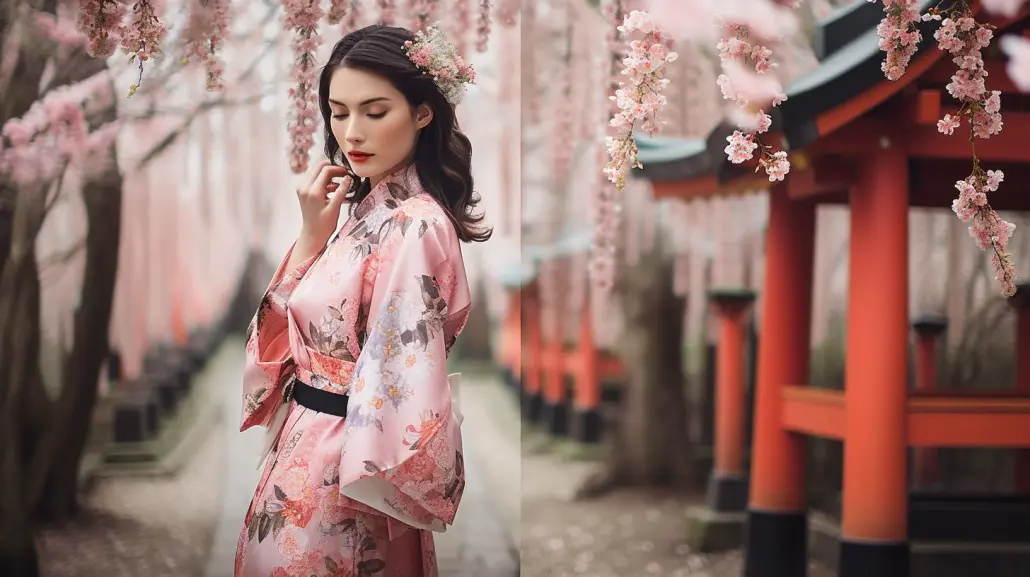
The story of Japanese women’s fashion begins with the iconic kimono. The kimono, literally meaning ‘thing to wear’, is a key symbol of traditional Japanese culture. It’s a timeless garment that has been worn for centuries. The beautiful, flowing robes adorned with intricate designs, have a grandeur and elegance that transcends time. However, in the modern fashion narrative, the kimono has become a starting point for a far more diverse style journey.
The Western Influence
Post World War II, the influence of western fashion began to make its mark on Japanese women’s fashion. The classic kimono started being replaced by western clothing for daily use. But the Japanese approach to western fashion was unique, blending the new influences with traditional aesthetics. The outcome was a fusion that not only retained Japanese culture but also accommodated global trends.
Harajuku: A Street Style Revolution
Fast forward to the late 20th century, we see the rise of the world-renowned Harajuku fashion. The name comes from Harajuku, a district in Tokyo, famous for its unique street style. This fashion subculture began in the 1980s and has since evolved into a global phenomenon. Harajuku fashion breaks all the rules, encouraging expression and individuality. It’s an embodiment of the rebellious spirit and creativity that defines contemporary Japanese women’s fashion.
Harajuku style comprises multiple substyles, including Lolita, Gothic Lolita, Gyaru, and many more. For instance, Lolita fashion is characterized by its doll-like aesthetics, with puffy skirts, bows, and intricate lace detailing. Gyaru fashion, on the other hand, is heavily influenced by Western fashion trends. Gyaru girls often sport heavy makeup, tanned skin, and high-heeled boots.
The Impact of Japanese Brands and Designers
Today, Japanese women’s fashion is making waves on international runways, thanks to pioneering brands and designers. A standout example is Comme des Garçons, led by Rei Kawakubo. The brand is famous for its avant-garde designs that challenge traditional ideas about fashion and beauty. Another influential figure is Issey Miyake, who is renowned for his innovative use of fabric and technology in creating sculptural garments.
Then there’s Uniqlo, a brand that has made Japanese fashion accessible worldwide. With their commitment to quality, functionality, and simplicity, Uniqlo has redefined everyday fashion.
There’s also Shiatzy Chen, a Taiwanese luxury fashion house that embraces a blend of Eastern and Western aesthetics in its designs. Their creations showcase the potential of East Asian influences in global high fashion.
And let’s not forget about Hello Kitty, a pop-culture phenomenon that has significantly influenced kawaii (cute) culture in Japan. From clothing and accessories to homeware, Hello Kitty has left an indelible mark on Japanese women’s fashion.
The Modern Elements of Japanese Women’s Fashion
As times have changed, so has the landscape of Japanese women’s fashion. Here’s a look at some of the modern clothing elements that have defined Japanese style in recent years.
Oversized Clothing
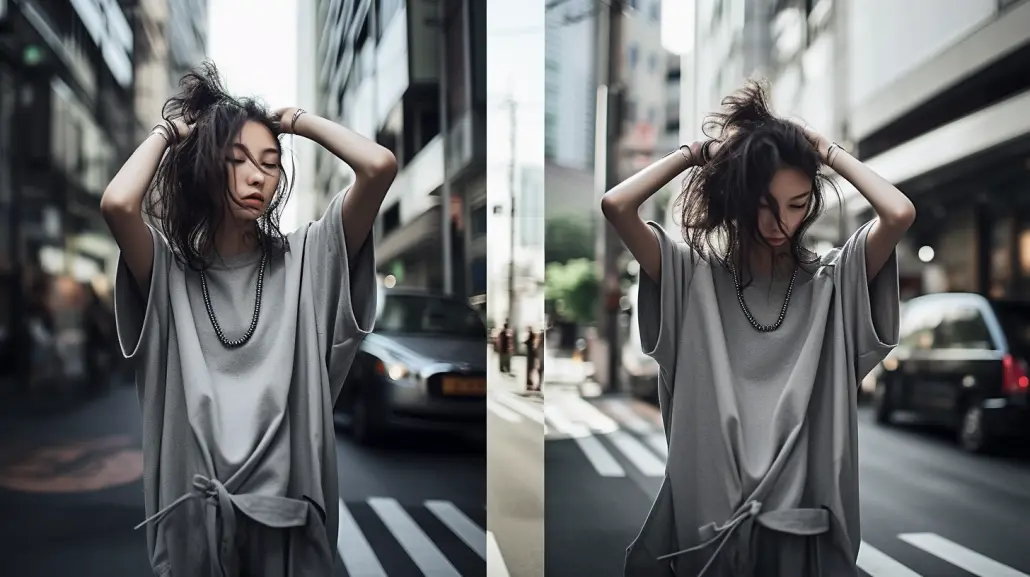
Oversized clothing is a distinctive element of modern Japanese fashion, inspired by the street style scenes of Harajuku and Shibuya. This style embraces comfort and fluidity, featuring pieces like oversized sweaters, baggy pants, and loose-fitting t-shirts. For example, brands like Uniqlo and Muji are known for their minimalist, comfortable, and roomy designs, which allow for easy movement and a relaxed look.
High Tech Sportswear
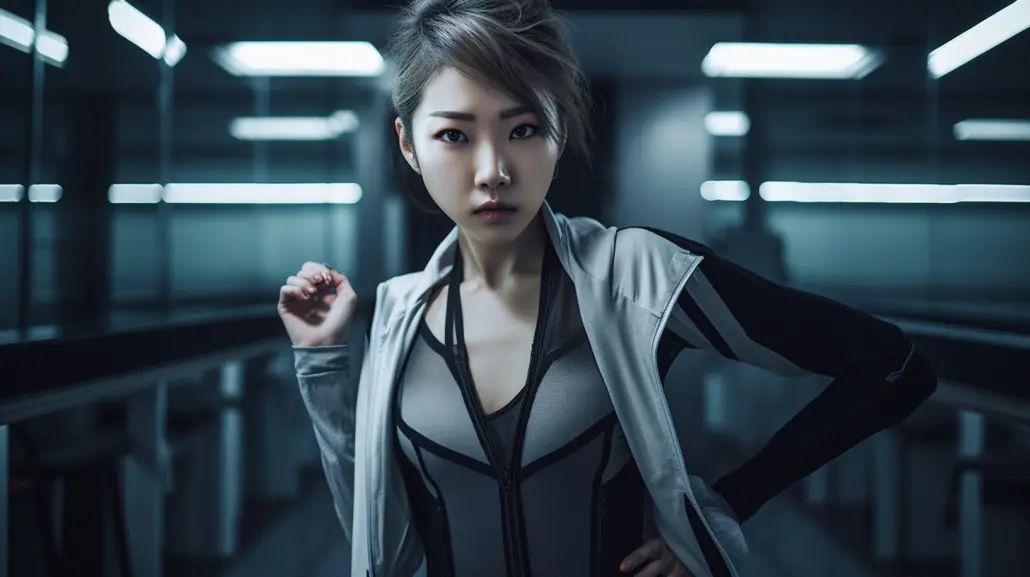
With a growing focus on active lifestyles and fitness, sportswear has become a significant part of Japanese women’s fashion. Brands like ASICS and Descente are blending performance with style to create chic, high-tech sportswear that’s as suited to the gym as it is to a casual day out.
Statement Accessories
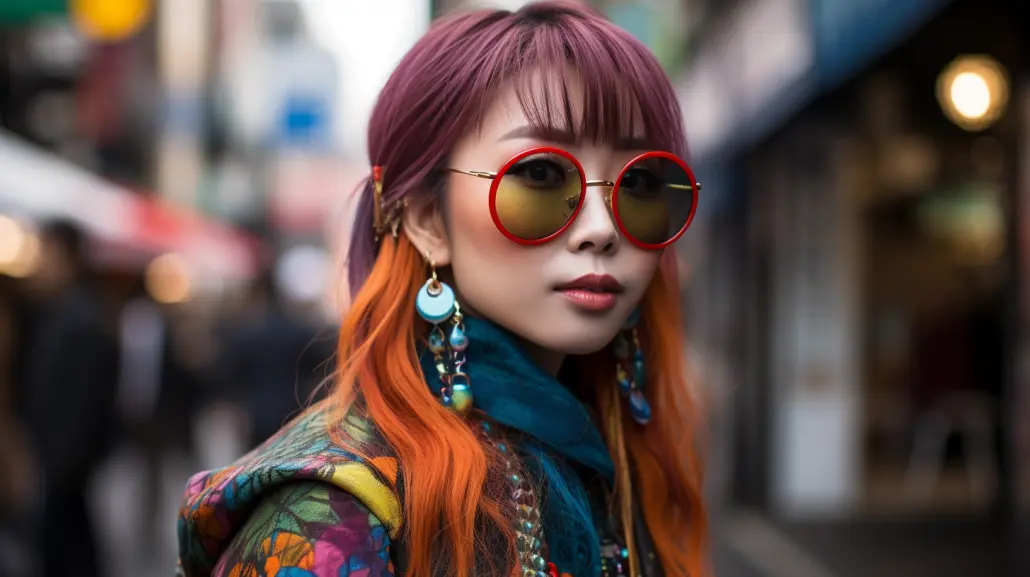
Accessories play a crucial role in adding individuality to an outfit, especially in the realm of Japanese street fashion. Whether it’s a quirky handbag, oversized sunglasses, colorful scarves, or chunky sneakers, these items can transform a simple outfit into a style statement. For instance, accessory brands like Samantha Thavasa and Comme des Garçons offer a range of eye-catching pieces that can elevate any look.
Minimalist Chic
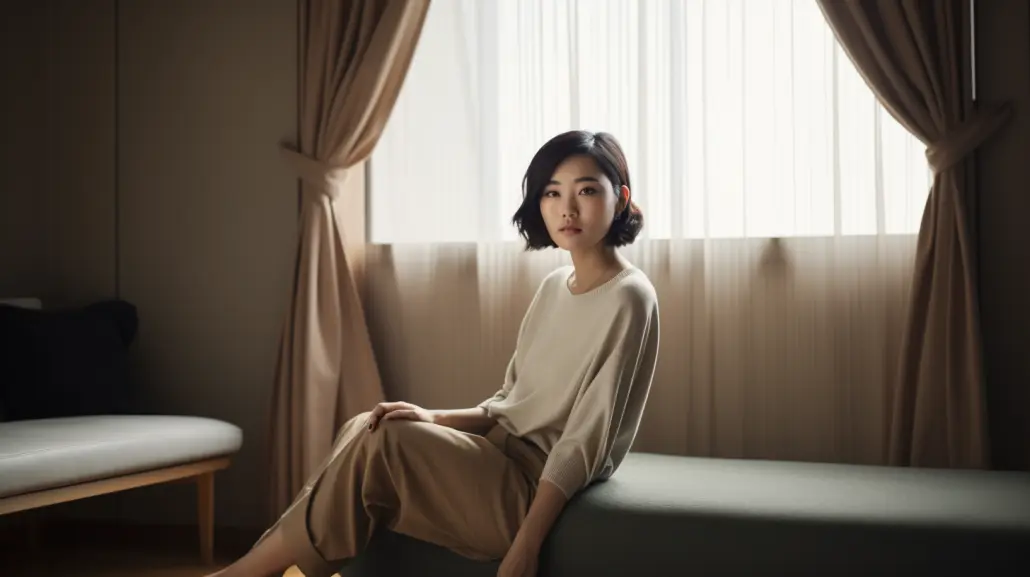
On the other end of the spectrum from the bold street styles, minimalist chic is another prominent aspect of modern Japanese fashion. This trend leans towards simple, functional, and well-designed pieces with a neutral color palette. Brands like Uniqlo, Muji, and BEAMS perfectly embody this aesthetic, offering quality essentials that can form the backbone of a versatile capsule wardrobe.
Contemporary Kimono Styles
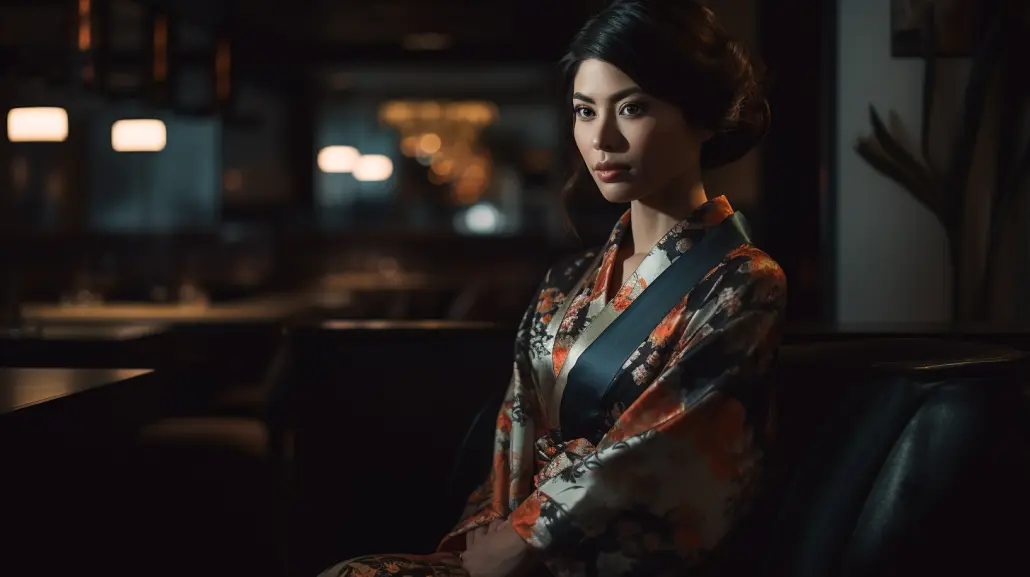
Modern interpretations of traditional kimonos are also a significant trend in Japanese women’s fashion. Designers are experimenting with kimono-inspired tops, jackets, and dresses, bringing the elegance of traditional Japanese design into the modern wardrobe. This fusion of old and new is a unique feature of Japanese fashion, reflecting a deep respect for cultural heritage alongside a readiness to innovate.
How to Incorporate Japanese Women’s Fashion in Your Wardrobe
Now that you’re acquainted with the evolution of Japanese women’s fashion, you might be wondering how to incorporate these styles into your own wardrobe.
Regardless of your body shape, whether you’re a V-shape, banana shape, or any other, there’s something in Japanese women’s fashion that will make you stand out.
Consider starting with something simple yet iconic like a kimono-style top. These come in a variety of designs, colors, and fabrics, perfect for pairing with jeans or skirts. If you prefer something more contemporary, a Uniqlo U T-shirt or sweater can be a cozy yet stylish option.
For those who are more daring, Harajuku-inspired pieces may be the ticket. You can incorporate elements of this style into your wardrobe with colorful, patterned leggings or over-sized graphic tees. Accessories, such as layered necklaces, oversized bows, or kawaii-inspired items, can also help you capture that distinctive Harajuku spirit.
And when it comes to dressing for the office, consider the elegant, refined styles that many Japanese designers excel at. A Miyake-style pleated midi skirt or a structured Comme des Garçons blazer could provide an edge to your business casual capsule wardrobe.
However, remember that the true essence of Japanese women’s fashion lies in self-expression. Don’t be afraid to experiment and find what suits you best, whether that means a full embrace of kawaii cuteness or a minimalist Uniqlo ensemble.
Japanese Women’s Fashion for All Seasons
One of the exciting aspects of Japanese women’s fashion is its adaptability to different seasons. For example, if you’re planning your spring capsule wardrobe, consider incorporating lightweight, pastel kimonos or cute, printed Uniqlo tees.
When the summer heat waves come rolling in, the style game remains strong. You might want to check our sizzling summer must-haves and add a touch of Japanese aesthetics with airy linen skirts, breathable cotton tops, and comfy open-toe sandals.
In the cooler months, Japanese women’s fashion proves its versatility with comfortable yet stylish pieces. Think of oversized sweaters, structured coats, and warm leggings. And if you’re looking for winter fashion inspiration, our guide on plus-size capsule wardrobe has you covered, regardless of your size.
Lastly, if you’re a traveler, the simplicity and functionality of many Japanese fashion pieces make them perfect for a travel capsule wardrobe. Items like versatile Uniqlo jackets, light, and wrinkle-resistant dresses, or stretchy, comfortable leggings are all fantastic choices for travel-friendly outfits.
The Future of Japanese Women’s Fashion
Just as Japanese women’s fashion has evolved throughout history, it continues to transform and adapt in the 21st century. In an increasingly globalized world, this is more relevant than ever.
The trend of sustainable fashion, for instance, is gradually making its mark on Japanese women’s fashion. Brands like Kowtow and Study NY are championing ethical fashion practices, creating garments that are not only stylish but also kind to the environment. This trend is expected to continue as more consumers prioritize sustainability in their fashion choices.
On another front, advances in technology are paving the way for high-tech fashion. Designer brands like Issey Miyake are leading this movement, employing cutting-edge technologies to create innovative, futuristic designs. From fabrics that change color with temperature to garments that can be transformed into various shapes, the possibilities seem endless.
Additionally, the rise of virtual and augmented reality technologies offers new avenues for fashion exploration. Imagine trying on outfits virtually before purchasing or experiencing a fashion show from the comfort of your home. These innovations could revolutionize the way we experience fashion.
In essence, the future of Japanese women’s fashion appears to be one of continued evolution, blending the best of tradition and innovation. With its inherent respect for craftsmanship and aesthetics, combined with a fearless attitude towards change, Japanese fashion will undoubtedly continue to inspire and fascinate us in the years to come.
The Personalities of Japanese Women’s Fashion
Understanding Japanese women’s fashion is about understanding the diverse personalities it embraces. Its evolution over the centuries has reflected the changing lifestyles, mindsets, and aspirations of Japanese women.
The Traditionalist
There are those who honor tradition. They appreciate the craftsmanship, heritage, and timeless elegance of the kimono. Their fashion choices are informed by cultural pride and a sense of continuity. This is not about being old-fashioned but about appreciating the roots of Japanese fashion and carrying those elements forward in a modern world.
The Innovator
Then there are the innovators. They are inspired by the likes of Rei Kawakubo and Issey Miyake, designers who are not afraid to break the mould and challenge conventional notions of fashion. They appreciate avant-garde designs, unusual silhouettes, and innovative materials. Their fashion choices reflect a daring spirit, a willingness to be different, and an appreciation for creativity.
The Global Citizen
The global citizens are influenced by trends and styles from around the world. They seamlessly blend Western styles with Japanese aesthetics, resulting in unique fashion statements. Brands like Uniqlo and Shiatzy Chen, with their globally-influenced yet distinctly Japanese designs, appeal to these individuals.
The Street Style Aficionado
And then there’s the street style aficionado. Embodying the vibrant, individualistic spirit of Harajuku fashion, they dress to express, not to impress. They are bold, colorful, and unafraid to stand out. They find joy in experimenting with different substyles, accessories, and makeup, always ready to push fashion boundaries.
Inspiring Change in Fashion
Japanese women’s fashion, with its diverse styles and dynamic evolution, has the power to inspire change in the global fashion scene. Whether it’s promoting sustainable fashion, pioneering technological innovations, or celebrating individuality and diversity, Japanese fashion has a lot to offer.
But what’s more, it has the power to inspire us, as individuals. It can inspire us to be fearless in our fashion choices, to embrace our individuality, to see fashion as a form of self-expression. It can encourage us to view our wardrobe not just as a collection of clothes, but as a palette for our creativity.
So, the next time you browse your wardrobe or go shopping, think about the lessons from Japanese women’s fashion. Think about how you can incorporate these elements into your own style.
Remember, fashion is not just about what’s in vogue. It’s about who you are and how you choose to express yourself. So, embrace the spirit of Japanese women’s fashion. Be bold. Be creative. Be you.
Wrap-Up
In the rich tapestry of global fashion, Japanese women’s fashion shines brightly. It is a vibrant blend of tradition and modernity, of local and global influences, of simplicity and complexity. It’s more than just a style – it’s a philosophy, a way of life.
From the elegance of the kimono to the audacity of Harajuku, the diversity of Japanese women’s fashion reflects the diversity of Japanese women themselves – bold, dynamic, and ever-evolving. Whether you’re a fashion aficionado or a curious explorer, there’s something in Japanese women’s fashion that will capture your imagination and inspire your style.
So, embark on your fashion journey. Explore, experiment, and express. After all, in the world of Japanese women’s fashion, the possibilities are as limitless as your imagination. Happy fashion adventuring!
Final Thoughts
When it comes to Japanese women’s fashion, it’s impossible to generalize. From the traditional elegance of the kimono to the rebellious spirit of Harajuku style, from the influence of revered designers to the role of groundbreaking brands, Japanese women’s fashion encompasses a spectrum of styles, each telling its unique story.
What makes Japanese women’s fashion truly special is its capacity for evolution, adaptation, and reinvention. It respects tradition, yet embraces innovation. It honors its cultural heritage, yet it’s not afraid to challenge the status quo.
In the end, it’s about self-expression and individuality. It’s a celebration of diversity, creativity, and personal style. And it’s an invitation to all women around the world to join this fashion journey, embracing the art of dressing with a dash of Japanese flair.
Whether you’re experimenting with your style, curating your wardrobe for different seasons, or exploring fashion from a global perspective, remember this – Japanese women’s fashion is not about following trends. It’s about finding joy in dressing up, expressing your unique personality, and ultimately, having fun with fashion.
So, let your fashion journey be inspired by the Japanese ethos – fearless, imaginative, and ever-evolving. Because, after all, fashion should be an adventure, not a chore.
Q&A: Japanese Women’s Fashion
Q: What characterizes Japanese casual fashion for females and how can I incorporate it into my style?
A: Japanese casual fashion for females is characterized by its blend of comfort, functionality, and style. It balances minimalism with fashion-forward elements, creating a look that’s both chic and relaxed.
Key pieces in Japanese casual fashion include oversized tees, loose-fitting trousers, and cozy sweaters. Sportswear, too, has a significant influence, with items like hoodies, joggers, and trainers often making an appearance. The color palette usually leans towards neutrals like white, black, gray, and beige, though pops of color are common as well.
To incorporate Japanese casual fashion into your wardrobe, start with basics. A high-quality white tee, a pair of comfortable jeans, and a versatile black dress are all good starting points. From there, you can layer on pieces like a denim jacket or a lightweight cardigan.
Footwear should be comfortable yet stylish. Sneakers are a popular choice, particularly clean, minimalist designs. For accessories, consider simple pieces like a tote bag or delicate jewelry.
Lastly, remember that Japanese casual fashion is all about simplicity and understatement. It’s not about making a loud statement, but about feeling good in what you wear and presenting a polished, effortless image. So, when in doubt, remember the old adage: less is more.
Brands like Uniqlo, BEAMS, and Muji are great places to start if you’re looking for Japanese casual fashion for females. Their collections feature a wide range of minimalist, high-quality basics that can form the foundation of your Japanese-inspired wardrobe.
Q: Can you recommend some Japanese clothing stores online where I can explore and purchase Japanese women’s fashion?
A: Absolutely, there’s a myriad of online stores where you can explore and shop for Japanese women’s fashion. Here are a few to get you started:
- Uniqlo: This popular Japanese brand offers everything from casual basics to workwear and activewear. Their simple, high-quality pieces are perfect for building a versatile wardrobe.
- Zozotown: Zozotown is one of Japan’s largest online fashion retailers. It offers a wide range of brands and styles, making it a great one-stop-shop for Japanese fashion.
- BEAMS: Known for their minimalist chic designs, BEAMS is a great destination if you’re seeking quality pieces that embody the understated elegance of Japanese fashion.
- Rakuten: As one of Japan’s leading online marketplaces, Rakuten hosts numerous fashion shops offering a diverse range of Japanese clothing.
- Comme des Garçons: If you’re interested in high-end Japanese fashion, this renowned brand’s online shop showcases their latest collections.
- WEAR: WEAR is a unique combination of a social media platform and a shopping site. Users share their outfits, and you can shop the pieces directly through the site.
Before making a purchase, check shipping policies as some stores may not offer international shipping, or it might be quite costly. Shopping from Japanese clothing stores online is a fantastic way to immerse yourself in Japanese women’s fashion, exploring the different styles, trends, and pieces that characterize this dynamic fashion scene.
Q: Where can I find Japanese style clothing in the USA or UK, either in physical stores or online?
A: There are several ways to find Japanese style clothing in the USA or UK. Many international brands inspired by Japanese aesthetics have physical stores in various locations across the country, and almost all offer online shopping as well.
- Uniqlo: Uniqlo is a Japanese brand with multiple stores in the USA and UK, including a flagship store on London’s Oxford Street. They offer a range of minimalist, quality basics that encapsulate Japanese casual style.
- Muji: Known for its minimalist designs, Muji is another Japanese brand with USA and UK stores. While they’re best known for homewares, they also offer clothing, including simple tops, trousers, and dresses.
- Dover Street Market: Dover Street Market in London is a multilevel concept store that carries high-end Japanese designers such as Comme des Garçons and Yohji Yamamoto.
- The Japanese Shop: While they mainly focus on gifts and homeware, The Japanese Shop also offers a selection of traditional Japanese clothing such as kimonos and yukatas.
- Rakuten: An online marketplace that offers products from various merchants, Rakuten features a variety of Japanese-style clothing that can be shipped to the USA and UK.
- ASOS: Although not a Japanese brand, ASOS’s online marketplace often carries Japanese-inspired designs and occasionally features Japanese brands.
Remember, Japanese style is all about quality, minimalism, and attention to detail. It’s not just about buying Japanese brands but embracing the ethos of Japanese fashion. Look for well-made, simple pieces, and don’t be afraid to invest in items that will last. With these tips, you’re sure to find Japanese style clothing that you’ll love, right here in the USA and UK.
Q: What are some types of traditional Japanese clothing, and what are their historical and cultural significance?
A: Traditional Japanese clothing is rich in history, symbolism, and craftsmanship. Here are a few significant examples:
- Kimono: The most iconic piece of traditional Japanese clothing, the kimono is a full-length robe characterized by wide sleeves and a sash called an “obi”. The word “kimono” literally means “thing to wear”. Traditionally, the color, pattern, and style of the kimono would signify the wearer’s social status, age, and marital status. Today, kimonos are typically worn on special occasions like weddings, tea ceremonies, and cultural festivals.
- Yukata: The yukata is a casual version of the kimono, typically worn in the summer. Made from lightweight materials like cotton, it’s commonly worn to summer festivals and fireworks displays.
- Hakama: The hakama are pleated trousers, traditionally worn over a kimono. Historically, they were worn by men, particularly samurais and nobles. However, in the modern era, women also wear hakama, especially for university graduation ceremonies.
- Haori: The haori is a hip- or thigh-length jacket worn over a kimono. Traditionally, it was worn by men, but it has since become unisex. It’s often adorned with family crests or other decorative motifs.
- Obi: The obi is a wide belt worn over a kimono or yukata. It can be tied in various ways, with different knots used for different occasions. The obi not only helps secure the kimono but also serves as a major fashion statement.
These traditional garments are a testament to Japan’s rich cultural history and exceptional craftsmanship. While they are not part of everyday wear for most people in Japan today, they continue to be worn and cherished for special occasions and cultural rituals, serving as a bridge between the past and the present.

